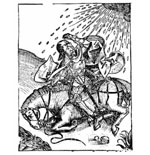
The Anatomy of Conversion
FROM DEBATE TO DISCOVERY
Think of falling in love. You begin by finding this girl’s eyes or laugh or kindness attractive, and perhaps not much more attractive than another’s, but as you get to know her and share some parts of your lives, one day you realize that you find her attractive in a way you cannot reduce to a liking for the different aspects of her appearance, personality, and character. She changes (to take my own case) from a girl with a heart-melting shy smile and gorgeous blue eyes sitting up front in the choir to Hope.
What you now think of her begins to affect how you see her, especially the aspects of her personality or character that are or might be flaws. What you had taken for impatience you now know to be enthusiasm, and what had seemed a self-centered disregard for others’ feelings you now see as single-mindedness.
What really are flaws you understand as the blemishes one invariably has in a fallen world, but you believe that they are, so to speak, accidents and not substance. In this you are not giving her the benefit of the doubt, as if the reality were disputable, but seeing her with a charity that lets you see her real beauty, marred but not erased or covered by her flaws. (If you are blessed, she sees you in the same way.)
But in the middle of this romantic movement from attraction to love, you ask many questions and even offer many objections: Do we agree on the fundamental things? Does she share my commitment to Christ and His Church? Would I care for her if she didn’t have that heart-melting smile? Why does she do this? Why in the world does she think that? How could she possibly believe those things?
You May Also Enjoy
Authentic authority, universality, and a firm theological grounding for social action -- these are the overarching factors that lead to Rome.
The fireplace without the fire is empty ritual and mere churchianity. The fire without the fireplace is chaos and hairsplitting and division.
When you have it you feel it is going to take you off to Rome (a sort of death for the Anglo-Catholic), but when you get better you easily forget it.

